
Michael Jordan is one of the most successful and recognizable basketball players in history. From his early career with the Chicago Bulls to his later years with the Washington Wizards, Jordan has left an indelible mark on the NBA. He is widely considered to be one of the greatest players of all time, having won six championships and five MVP awards. His influence on the game stretches beyond his individual accomplishments, as he has inspired generations of fans and players alike with his skills and competitive spirit.
Jordan’s fame began during his college career at North Carolina. After winning a national championship with the Tar Heels in 1982, he was drafted third overall by the Chicago Bulls in 1984. In Chicago, Jordan quickly established himself as a dominant player, leading the team to six championships over eight seasons. In addition to his scoring prowess, he was also known for spectacular dunks and defense that earned him three Defensive Player of the Year awards. His celebrity status was only enhanced by his highly successful endorsement deals with Nike, Gatorade, and Hanes.
Jordan briefly retired from basketball in 1993 to pursue a career in baseball but returned to the court two years later with even greater success. He led the Bulls to three more championships before retiring again in 1998. After a brief stint playing minor league baseball, Jordan returned to basketball for two final seasons with the Washington Wizards before finally retiring for good in 2003.
Since then, Jordan has become an active businessman and philanthropist. He is now majority owner of the Charlotte Hornets and works regularly with charities such as the Make-A-Wish Foundation and the James R. Jordan Foundation. He is also a member of the Basketball Hall of Fame and was awarded the Presidential Medal of Freedom in 2016.
Michael Jordan’s impact on basketball and the world at large cannot be overstated. From the courts to the boardroom, he continues to inspire generations of fans and players with his skill and passion for the game.
Michael Jordan – Early Years
Michael Jeffrey Jordan was born in Fort Greene, Brooklyn, New York City on February 17, 1963 to bank employee Deloris (née Peoples) and equipment supervisor James R. Jordan Sr. When he was five years old, his family moved to Wilmington, North Carolina where he attended Emsley A. Laney High School. At the time, Jordan was too short to play on the varsity basketball team at 5 feet 11 inches (1.80 m).
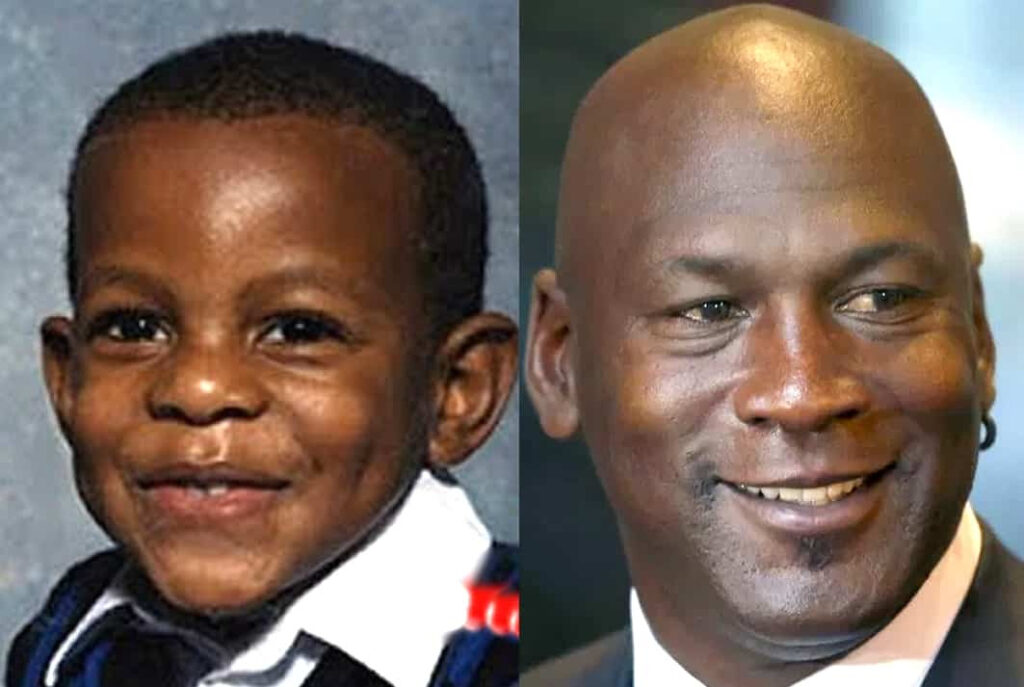
However, determined to prove himself, he worked hard over the summer and improved enough to make the roster. Over his final two years of high school he averaged more than 25 points per game (ppg), 12 rebounds (rpg), and six assists per game (apg). His senior year saw him selected to play in the 1981 McDonald’s All-American Game where he scored 30 points. After earning multiple college basketball offers from Duke University, University of North Carolina, South Carolina, Syracuse, and Virginia; Jordan chose to attend University of North Carolina at Chapel Hill majoring in cultural geography with a basketball scholarship.
Michael Jordan – College
As a freshman, Jordan was named ACC Freshman of the Year after he averaged 13.4 points per game on 53.4% shooting (field goal percentage). He made the iconic game-winning jump shot in the 1982 NCAA Championship game against Georgetown and their star player Patrick Ewing, which Jordan later described as a major turning point in his basketball career. During his three seasons with the Tar Heels, he averaged 17.7 ppg on 54.0% shooting while also contributing 5.0 rebounds and 1.8 assists per game.
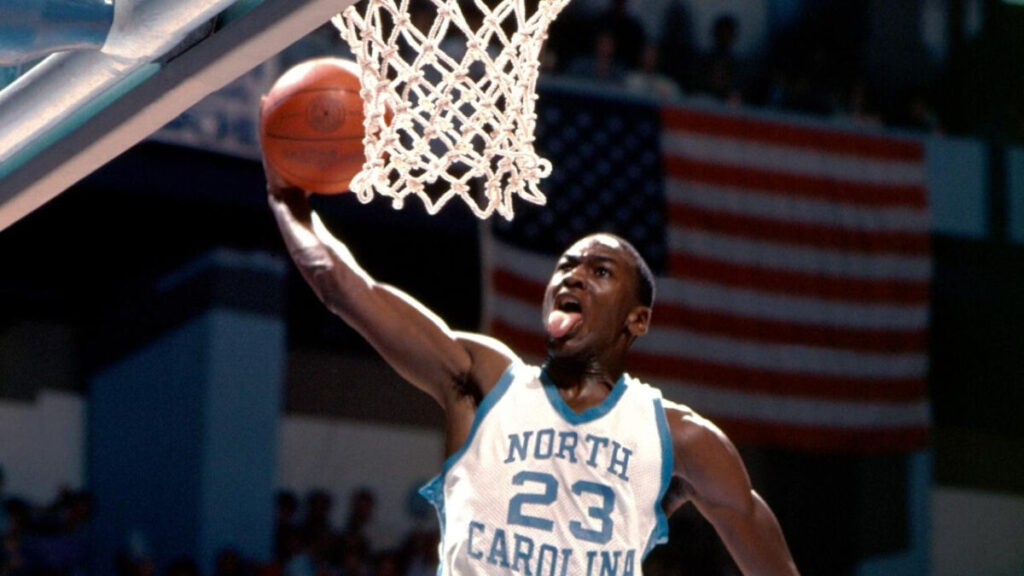
Jordan earned consensus selection to the NCAA All-American First Team for both his sophomore (1983) and junior (1984) seasons. In 1984, he won both the Naismith and Wooden College Player of the Year awards before leaving North Carolina one year prior to graduation to enter the NBA draft. He eventually returned to complete his degree in 1986 when he graduated with a Bachelor of Arts degree in geography; then, in 2002, was named to the ACC 50th Anniversary men’s basketball team honoring its 50 greatest players ever.
Michael Jordan – Chicago Bulls
The Chicago Bulls chose Michael Jordan with the third overall pick in the 1984 NBA draft, behind Hakeem Olajuwon (Houston Rockets) and Sam Bowie (Portland Trail Blazers). Portland’s decision to opt for Bowie over Jordan has been characterized as one of the worst draft picks in North American professional sports history. Jordan made his NBA debut on October 26, 1984 at Chicago Stadium and scored 16 points, a ticket stub from that game recently selling for $264,000 at auction.
During his rookie season, Jordan averaged 28.2 ppg on 51.5% shooting and played a key role in transforming the Bulls into playoff contenders – he was an instant fan favorite in opposing arenas and was voted an All-Star starter. The 1985 NBA All-Star Game saw controversy arise when several veterans refused to pass him the ball throughout the game – yet this did not affect his regular season performance, going on to be named NBA Rookie of the Year. Despite this progress, the Bulls finished 38–44 and were eliminated by the Milwaukee Bucks in four games during the first round of playoffs.
On August 26th, 1985, Michael Jordan made an indelible mark on the basketball world during a Nike exhibition game in Trieste, Italy. With a single dunk, he shattered the backboard glass, making it a defining moment of his ascent to stardom. The shoes Jordan wore that day were auctioned off in 2020 for an astonishing $615,000 – a record for any pair of sneakers. Unfortunately, his 1985–86 season was cut short when he suffered a broken foot in the third game of the year and missed 64 games. Despite this setback, the Bulls still managed to make it to the playoffs with a 30–52 record – one of the worst records ever of any team to qualify.

When Jordan returned in time for postseason play, he set an NBA record for points in a playoff game with an incredible 63 in Game 2 against the Boston Celtics. However, the Celtics ultimately swept the series. Jordan fully recovered by the 1986–87 season, becoming the second player (after Wilt Chamberlain) to score 3,000 points in a season and was also the first ever to have 200 steals and 100 blocked shots in one season. Despite his success, Magic Johnson won MVP that year. The Bulls went on to secure 40 wins and make it to the playoffs again, but were swept by Boston once more.
Jordan continued to be a dominant force in the 1988–89 season, leading the league in scoring with an average of 32.5 points per game (ppg) on 53.8% shooting from the field, along with 8 rebounds (rpg) and 8 assists (apg). Chicago’s point guard, Sam Vincent, was having trouble running the offense, causing Jordan to express his frustration with head coach Doug Collins. As a result, Collins put Jordan at point guard and he responded by averaging 10 triple-doubles in eleven games, with 33.6 ppg, 11.4 rpg, 10.8 apg, 2.9 spg, and 0.8 bpg on 51% shooting.
With Jordan leading the way, the Bulls finished 50–32 and made it out of the first round of the playoffs for the first time in Jordan’s career, beating the Cleveland Cavaliers in five games. However, they were unable to advance further as they lost to the more experienced Detroit Pistons in five games during the Eastern Conference Semifinals; the Pistons were led by Isiah Thomas and a group of physical players known as the “Bad Boys”. For his efforts in this season, Jordan was named MVP of the league and Defensive Player of the Year due to his 1.6 blocks per game (bpg), 3.1 steals per game (spg), and his role in helping lead the Bulls defense to allowing the fewest points per game in the league.
The 1989-90 Bulls were a force to be reckoned with, having a core group of Jordan, Scottie Pippen and Horace Grant, plus the newly appointed Phil Jackson as coach. On March 28th, Jordan scored a career-high 69 points in a 117–113 road win over the Cavaliers, averaging an incredible 33.6 ppg on 52.6% shooting, plus 6.9 rpg and 6.3 apg. The Bulls ended the season with a 55–27 record, advancing to the Eastern Conference Finals after defeating the Bucks and Philadelphia 76ers. Unfortunately, they were unable to overcome the Pistons despite pushing the series to seven games, losing to them for the third consecutive season.
32 years ago today, Michael Jordan pulls off one of the greatest layups in NBA history 🐐 pic.twitter.com/9qHXSqtUkI
— Ballislife.com (@Ballislife) February 16, 2023
In the 1990–91 season, Jordan had a remarkable performance, winning his second MVP award with averages of 31.5 points per game on 53.9% shooting, 6 rebounds and 5.5 assists. The Bulls also achieved success in the regular season, marking a franchise record with 61 wins and securing their first division title in sixteen years. Led by Scottie Pippen’s All-Star play, they went on to beat the New York Knicks and Philadelphia 76ers in the opening two rounds of the playoffs before sweeping the Detroit Pistons in the Eastern Conference Finals.
This propelled them to their first ever NBA Finals appearance against the Los Angeles Lakers and their formidable duo of Magic Johnson and James Worthy. The Bulls ultimately won the series 4-1, going 15-2 in the playoffs along the way. A defining moment from Game 2 came when Jordan avoided a potential Sam Perkins block by switching the ball from his right hand to his left mid-air for an iconic dunk. During his first Finals appearance, Jordan put up an impressive 31.2 points per game on 56% shooting from the field, 11.4 assists, 6.6 rebounds, 2.8 steals and 1.4 blocks per game – enough to earn him his first NBA Finals MVP award and cause him to cry tears of joy while holding the trophy aloft.
Jordan and the Bulls maintained their supremacy during the 1991-92 season, achieving a record of 67-15, surpassing the franchise record from the previous season. Jordan was awarded his second consecutive MVP with stats of 30.1 points per game, 6.4 rebounds per game, and 6.1 assists per game on 52% shooting. After a challenging seven-game series against the New York Knicks in the second round of playoffs and a six-game series against the Cleveland Cavaliers in the Conference Finals, the Bulls faced Clyde Drexler and the Portland Trail Blazers in the Finals. The media was hoping to recreate a Magic-Bird rivalry by emphasizing the similarities between “Air” Jordan and Clyde “The Glide” prior to the Finals.
When the first steps of Dream Team were taken… 🔥
— FIBA (@FIBA) February 17, 2023
Enjoy a minute of crazy Michael Jordan highlights from 1992 Olympic Qualifying Tournament! pic.twitter.com/TM0ZTL2YKE
In Game 1, Jordan scored a record-breaking 35 points in the first half alone, including a monumental six three-pointers. After the sixth three-pointer, he ran down the court with a shrug as he glanced at those sitting courtside; Marv Albert later reported that it was as if Jordan was saying: “I can’t believe I’m doing this.” The Bulls ended up winning Game 1 and went on to defeat the Blazers in six games. Jordan was named Finals MVP for a second consecutive year, averaging 35.8 points per game, 4.8 rebounds per game, 6.5 assists per game, and shooting 52.6% from the floor.
In the 1992-93 season, Michael Jordan’s streak of consecutive MVPs came to an end, as Charles Barkley won the award, which visibly upset him. However, Jordan and the Bulls advanced to the 1993 NBA Finals against Barkley’s Phoenix Suns. The Bulls went on to win their third championship due to John Paxson’s game-winning shot and Horace Grant’s last-second block, but Jordan was still their leader.
He set a record in the Finals by averaging 41.0 points per game throughout the six games, becoming the first player in NBA history to be awarded three straight Finals MVP awards. Moreover, he scored more than 30 points in every game and 40 or more points in four consecutive games. With his third Finals victory, Jordan had earned seven scoring titles and three championships over a span of seven years – yet there were signs that he was growing weary of his immense popularity and all of its associated non-basketball obligations.
Michael Jordan – Gambling Controversy
In 1993, during the Bulls’ NBA playoffs, Michael Jordan was spotted gambling at Atlantic City, New Jersey on the eve of Game 2 of the Eastern Conference Finals against the New York Knicks. The preceding year, he had acknowledged owing $57,000 in gambling losses, and Richard Esquinas wrote a book in 1993 asserting that Jordan had won $1.25 million from him on the golf course. David Stern, the NBA’s commissioner, denied in 1995 and 2006 that Jordan’s 1993 retirement was a secret penalty for gambling, but the rumor persisted.
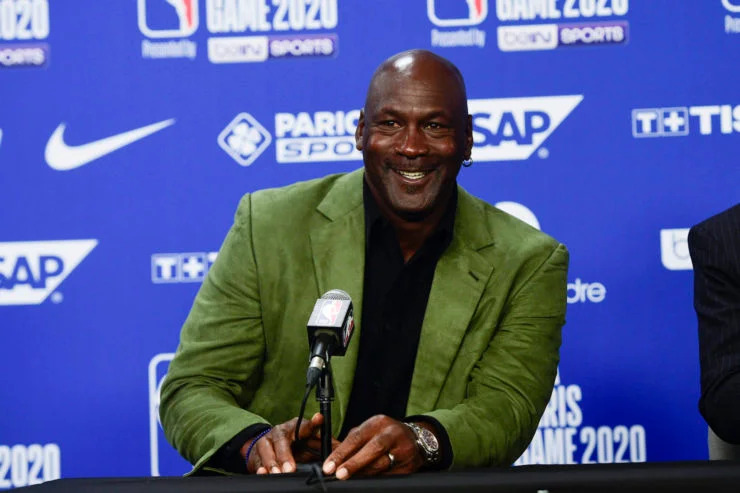
In 2005, when asked by Ed Bradley of 60 Minutes about his gambling habit, Jordan admitted to making imprudent decisions. He said: “Yeah, I’ve gotten myself into situations where I would not walk away and I’ve pushed the envelope. Is that compulsive? Yeah, it depends on how you look at it. If you’re willing to jeopardize your livelihood and your family, then yeah.” When Bradley questioned if his wagering had ever endangered his career or family, he replied: “No.” In 2010, Ron Shelton who directed Jordan Rides the Bus shared that he initially assumed the NBA had suspended him, but research had convinced him otherwise.
Michael Jordan – Stint in Minor League Baseball
On October 6, 1993, Jordan made the shocking announcement that he was retiring from basketball, citing a loss of desire to play the game. This followed the tragic murder of his beloved father, James R. Jordan Sr., only three months earlier. Jordan had been close to his father and often imitated the way he stuck out his tongue when absorbed in work; this gesture would later become his signature move on the court.
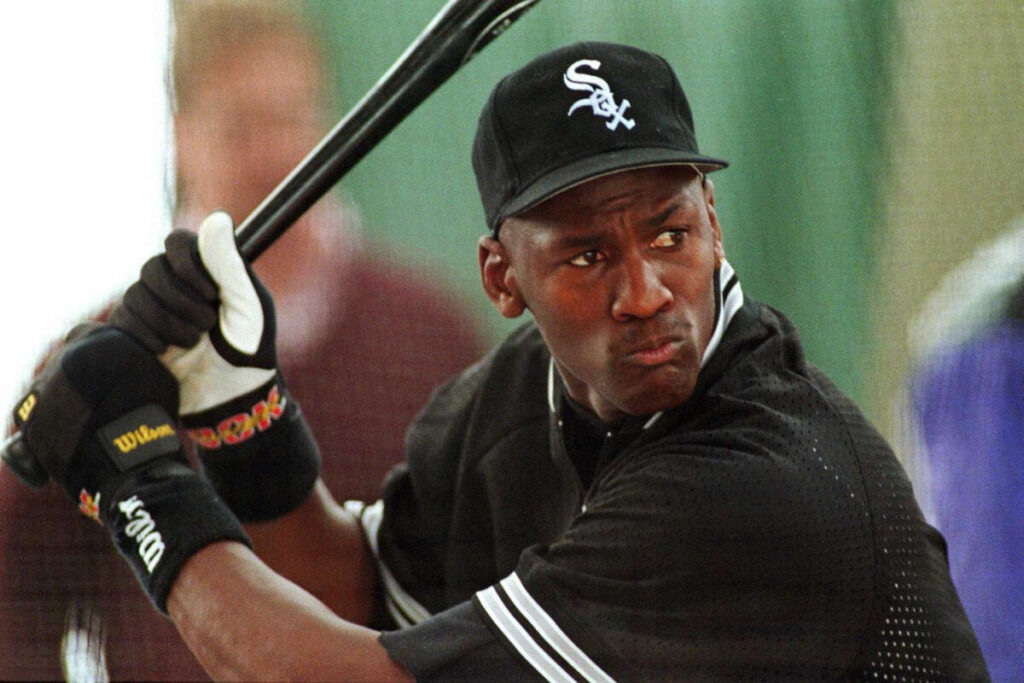
Following his retirement, Jordan decided to pursue his father’s dream of him becoming a Major League Baseball player and signed with the Chicago White Sox in February 1994. He reported to spring training in Sarasota, Florida, and was assigned to the team’s minor league system on March 31. Jordan played one exhibition game for the White Sox against the Chicago Cubs on April 7, during which he hit an RBI-double to tie the game. He also played for the Birmingham Barons and Scottsdale Scorpions in the Arizona Fall League throughout 1994. On November 1, 1994, the Bulls honored Jordan by retiring his No. 23 jersey and erecting a permanent sculpture known as The Spirit outside the new United Center.
Michael Jordan – Return to the NBA
After the 1993-94 season, the Chicago Bulls were a far cry from the championship team they had been two years prior. Struggling to make the playoffs, their fortunes changed when Michael Jordan announced his return to the NBA on March 18th 1995 with the simple statement: “I’m back”. Despite his long absence from the league, Jordan quickly regained his form, hitting a game-winning jump shot against Atlanta in his fourth game back and scoring 55 points against the New York Knicks at Madison Square Garden shortly after.
Boosted by his comeback, the Bulls went 13–4 to make the playoffs and advanced to the Eastern Conference Semifinals against the Orlando Magic. Before Game 2 of the series, Jordan decided to resume wearing his original No. 23 jersey; he was fined $25,000 for failing to report this change and an additional $5,000 for wearing white sneakers when the rest of the Bulls wore black. He averaged 31 points per game in the playoffs, but Orlando ultimately won the series in six games.

Motivated by their playoff defeat, Jordan trained vigorously for the 1995-96 season. The Bulls received a major boost with the addition of rebound specialist Dennis Rodman and proceeded to dominate the league, starting the season off 41-3. The Bulls finished the regular season with a record-breaking 72-10 mark, a record that remained unbroken for two decades until it was surpassed by the 2015-16 Golden State Warriors. Jordan led the league in scoring, averaging 30.4 points per game, and he won both the regular season and All-Star Game MVP awards.
In the playoffs, the Bulls only dropped three games in four series (Miami Heat 3–0, New York Knicks 4–1, and Orlando Magic 4–0), eventually defeating the Seattle SuperSonics 4–2 in the NBA Finals to win their fourth championship. Jordan was named Finals MVP for a record fourth time, surpassing Magic Johnson’s three Finals MVP awards; he also achieved only the second sweep of the MVP awards in the All-Star Game, regular season, and NBA Finals after Willis Reed in the 1969–70 season. After winning his first title since his father’s murder, Jordan reacted emotionally, clutching the game ball and crying on the locker room floor.
In the following 1996–97 season, the Bulls had an impressive 69–11 record but ended up losing their last two games to finish 69–13, missing out on another 70-win season. They advanced to the Finals again where they faced off against the Utah Jazz team which included Karl Malone who had beat Jordan for NBA MVP award by a narrow margin (986–957). The series between them featured two of Jordan’s most memorable clutch moments.
He won Game 1 for the Bulls with a buzzer-beating jump shot and in Game 5, with both teams tied at 2 apiece and Jordan feeling feverish and dehydrated from a stomach virus, he still managed to score 38 points including a game-deciding 3-pointer with 25 seconds left on the clock. The Bulls won 90–88 and went on to win the series in six games. For an unprecedented fifth time in as many Finals appearances, Jordan was awarded with Finals MVP award. During 1997 NBA All-Star Game, he posted his first triple-double in All-Star Game history but Glen Rice was named MVP instead.
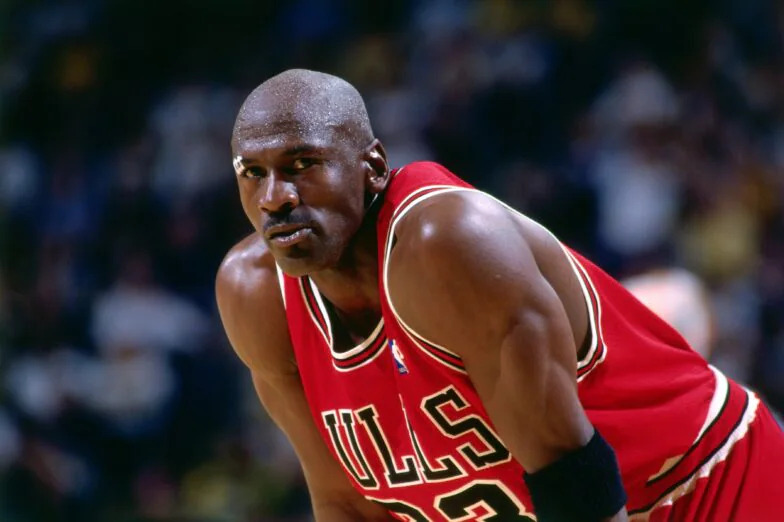
Jordan and the Bulls had an impressive 62–20 record during the 1997–98 season. Jordan earned his fifth regular season MVP award, All-NBA First Team honors, First Defensive Team recognition, and was named the All-Star Game MVP. They went on to win their third consecutive Eastern Conference Championship, surviving a seven-game series with the Indiana Pacers in the Eastern Conference Finals. In the NBA Finals, they faced off against the Utah Jazz for a rematch.
On June 14, 1998, the Bulls returned to the Delta Center for Game 6 leading the series 3–2. Jordan put together one of the most remarkable clutch performances in NBA Finals history. With 41.9 seconds remaining and Chicago trailing 86–83, he received an inbound pass and drove to the basket, sinking a shot over several Jazz defenders to cut Utah’s lead to 86–85. He then stole the ball from Malone’s hands and dribbling down court with 10 seconds left. He paused, eyeing his defender Bryon Russell before crossing over to his left and making a top-key jumper over a stumbling Russell with 5.2 seconds left, giving Chicago an 87–86 lead.
The Jazz’ John Stockton narrowly missed a game-winning three-pointer as the buzzer sounded and Jordan and the Bulls won their sixth NBA championship, achieving their second three-peat in the decade. Jordan was voted Finals MVP for a record sixth time after leading all scorers with an average of 33.5 ppg, including 45 in Game 6. The 1998 Finals holds the highest television rating of any Finals series in history, and Game 6 holds the highest television rating of any game in NBA history.
Michael Jordan – Second Retirement
With his contract expiring and Scottie Pippen and Dennis Rodman’s imminent departures, Jordan retired for the second time on January 13, 1999. On January 19, 2000, he returned to the NBA in a new role as part owner and president of basketball operations for the Washington Wizards. His job entailed controlling all aspects of the team’s basketball operations, with the final say in all personnel matters. Although Jordan was able to rid the team of several unpopular players, he made a questionable move by selecting high schooler Kwame Brown with the first pick in the 2001 NBA draft; Brown was later traded away after four seasons.
20 years ago today, Michael Jordan’s final All Star Game. pic.twitter.com/iXqd2Q3roq
— TodayInSports (@TodayInSportsCo) February 9, 2023
Despite declaring that he was “99.9% certain” he would never play another NBA game in January 1999, Jordan began training for a comeback in the summer of 2001. He held invitation-only camps for NBA players in Chicago and hired his former Chicago Bulls head coach Doug Collins as Washington’s coach for the upcoming season, leading many to speculate that this hinted at another Jordan return.
Michael Jordan – Washington Wizards
On September 25, 2001, Michael Jordan announced his return to the NBA to play for the Washington Wizards, expressing his intention to donate all of his salary as a player to those affected by the tragic events of 9/11. In the 2001–02 season, Jordan was an MVP candidate, leading the Wizards to a winning record and playoff contention despite being plagued by injuries. He played in 60 games that season, averaging 24.3 points per game, 5.4 assists, and 6.0 rebounds, shooting 41.9% from the field. His last seven appearances were off the bench, averaging 20 minutes per game. The Wizards finished with a 37–45 record, an 18-game improvement from the previous season.
In 2003, Jordan made history by becoming the all-time leading scorer in All-Star Game history, passing Kareem Abdul-Jabbar’s record (since broken by Kobe Bryant and LeBron James). That same year he was the only Washington player to play in all 82 games, starting 67 and coming off the bench in 15, averaging 20 points per game, 6.1 rebounds, 3.8 assists, and 1.5 steals per game with a 45% field goal percentage and 82% free throw percentage.
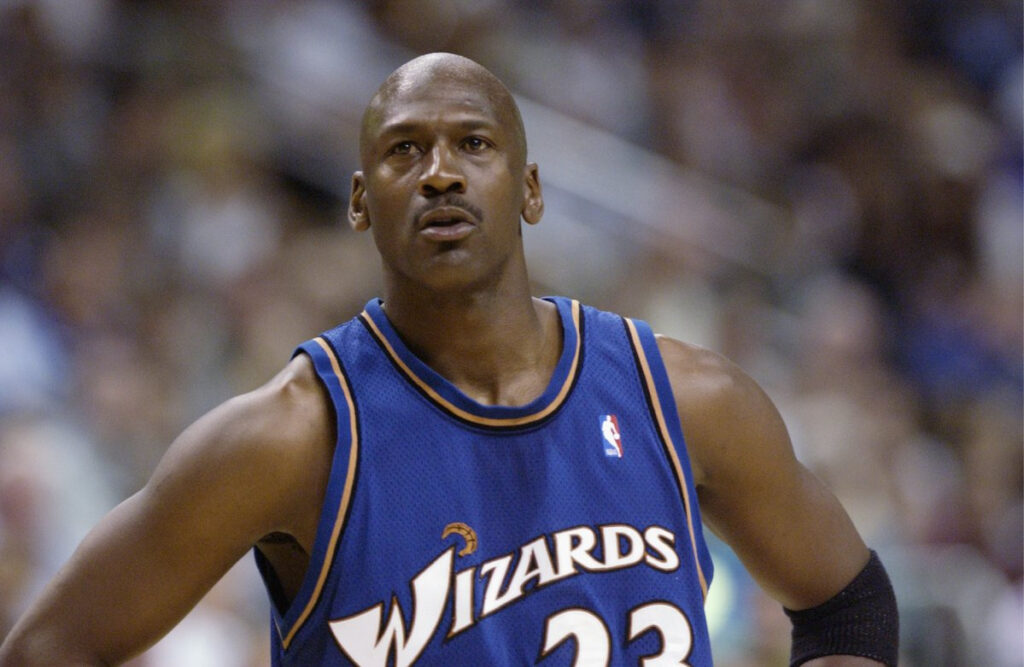
Despite turning 40 during the season he still managed to score 20+ points 42 times and 30+ points nine times. On February 21st he became the first 40-year-old to score 43 points in an NBA game. During his tenure with the Wizards every home game at MCI Center was sold out and they were the second most watched team in the NBA, averaging 20,172 fans at home and 19,311 on the road. Unfortunately his final two seasons did not result in a playoff appearance for the Wizards and he openly criticized his teammates for their lack of focus and intensity throughout his time there.
Michael Jordan – Final Retirement
As the 2002–03 season marked Michael Jordan’s final year in the NBA, tributes were abundant. On April 11th, 2003, the Miami Heat honored him by retiring the No. 23 jersey, even though he had never played for the team. At the 2003 All-Star Game, Jordan was offered a starting spot from Tracy McGrady and Allen Iverson but declined both; he finally accepted Vince Carter’s spot.
His last game was held in Philadelphia on April 16th, where he scored 13 points before being replaced by Larry Hughes four minutes into the third quarter. The crowd began chanting “We want Mike!” until coach Doug Collins convinced him to return to the court with 2:35 left in the fourth quarter. He was then intentionally fouled by Eric Snow so that he could make two free throws, followed by a three-minute standing ovation from his teammates, opponents, officials, and 21,257 fans.
Michael Jordan – National Team Career
Jordan made a remarkable debut for the US national basketball team at the 1983 Pan American Games in Caracas, Venezuela. He led the talented roster to a gold medal victory under the guidance of coach Jack Hartman, averaging 17.3 points per game. The following year he would again take home gold in the 1984 Summer Olympics.
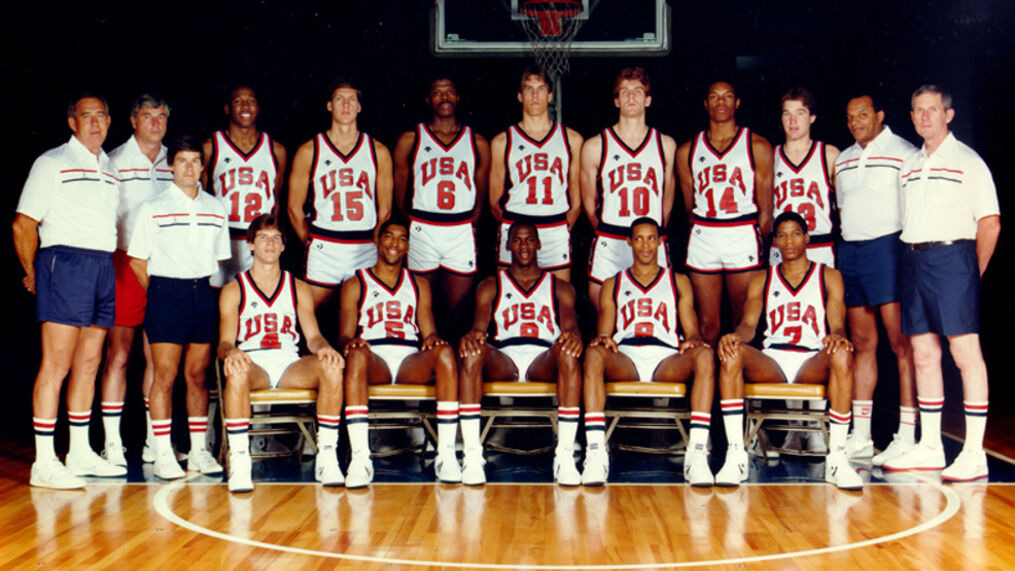
This time Bob Knight was the head coach and the squad included Patrick Ewing, Sam Perkins, Chris Mullin, Steve Alford, and Wayman Tisdale. Jordan was a leading scorer once more with 17.1 ppg and even went on to be part of a historic “Dream Team” in 1992 that included Larry Bird and Magic Johnson. At the 1992 Tournament of the Americas and Olympics, Jordan was undefeated with 30 wins out of 30 games played and finished as the second highest scorer in both competitions with 14.9 ppg.
Michael Jordan – Post Retirement
After his third retirement, Jordan assumed that he would be able to return to his role as Director of Basketball Operations for the Wizards. Unfortunately, his previous tenure in the front office had been met with mixed results and may have contributed to the controversial trade involving Richard “Rip” Hamilton and Jerry Stackhouse, although Jordan was not officially part of the decision-making process in 2002.
To Jordan’s surprise, on May 7, 2003, Wizard’s owner Abe Pollin fired him from his position as president of basketball operations. Jordan expressed feeling betrayed by this abrupt dismissal and stated that had he known this would happen, he never would have come back to play for the Wizards.
Watching Michael Jordan is like watching Michelangelo or Da Vinci at work. #GOAT𓃵 pic.twitter.com/F2JI4nDsYg
— Martin (@Readestates) February 9, 2023
In an effort to keep himself occupied over the following years, Jordan stayed in shape, played golf in celebrity charity tournaments, and spent time with his family in Chicago. He also continued to promote his signature clothing line and began a new venture with Michael Jordan Motorsports – a professional closed-course motorcycle road racing team that competed with two Suzukis in the premier Superbike championship sanctioned by the American Motorcyclist Association (AMA) until 2013.
Michael Jordan – Charlotte Bobcats/Hornets
In June 2006, Jordan purchased a minority stake in the Charlotte Bobcats (now known as the Hornets), becoming the second-largest shareholder behind majority owner Robert L. Johnson. As part of the deal, Jordan took control of the team’s basketball operations and refused to be included in any marketing campaigns. A decade earlier, he had tried to become part-owner of the city’s original NBA team, the Charlotte Hornets, but talks failed when George Shinn declined to give him full control of basketball operations.
In February 2010, reports indicated that Jordan was seeking majority ownership of the Bobcats. After a few weeks, it became obvious that he and former Houston Rockets president George Postolos were leading contenders for the team. On March 17, the NBA Board of Governors unanimously approved Jordan’s purchase, making him the first former player to become the majority owner of an NBA team and its only African-American majority owner. In 2023 however, Johnson expressed regret at selling the Charlotte Hornets to him.
During the 2011 NBA lockout, The New York Times reported that Jordan had led a group of hardline owners who wanted to cap players’ share of basketball-related income at 50 percent or lower. This prompted criticism from Jason Whitlock of FoxSports.com who called him “a hypocrite sellout” for wanting current players “to pay for his incompetence” citing his executive decisions to draft Kwame Brown and Adam Morrison.
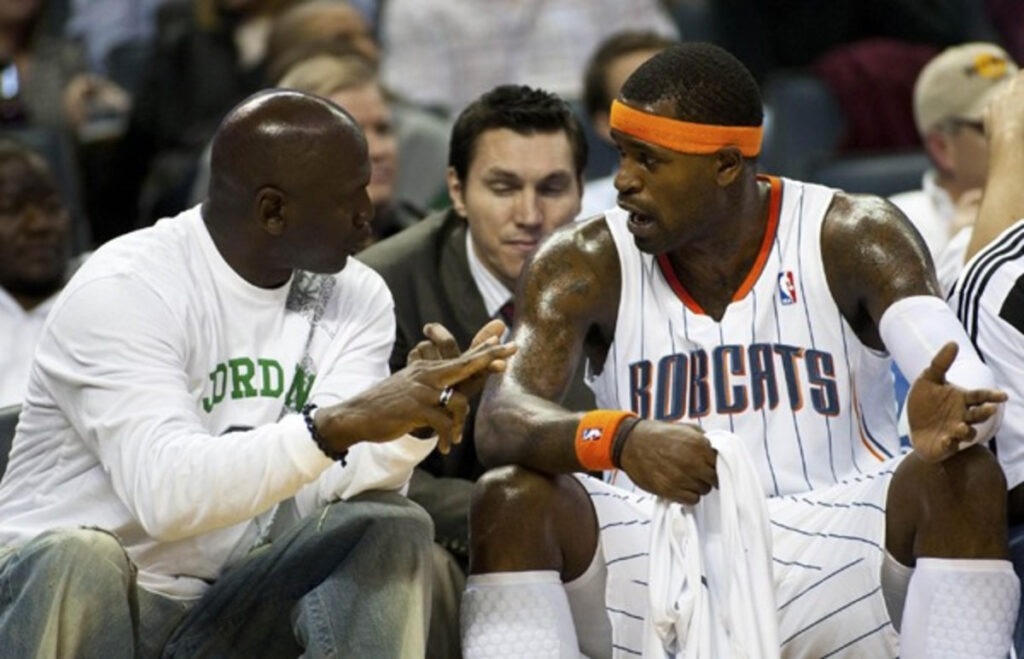
In the shortened 66 game season during 2011–12 NBA season, the Bobcats posted a 7–59 record and closed out with a 23-game losing streak; their .106 winning percentage was had been the worst in NBA history ever recorded. Ahead of next season, Jordan said: “I’m not real happy about the record book scenario last year. It’s very, very frustrating.”
Finally, in 2019 Jordan sold a minority piece of his ownership in Hornets to Gabe Plotkin and Daniel Sundheim while retaining a majority stake and his role as chairman.
Michael Jordan – Personal Life
Jordan is the fourth of five siblings, two brothers, Larry Jordan and James R. Jordan Jr., one older sister, Deloris, and a younger sister, Roslyn. His nephew Justin Jordan played NCAA Division I basketball for UNC Greensboro Spartans and is now a scout for the Charlotte Hornets. In 1989, Jordan married Juanita Vanoy in Las Vegas, Nevada. They had two sons, Jeffrey and Marcus, as well as a daughter, Jasmine. The two were divorced in 2006 after mutual agreement.
Following this settlement, reported to be the largest celebrity divorce settlement on record at the time, Jordan purchased a lot in Highland Park, Illinois where he built a 56,000 square-foot mansion which was completed in 1995 and later listed for sale in 2012. He also owns homes in North Carolina and Jupiter Island, Florida. His two sons attended Loyola Academy while his daughter Jasmine became a mother in 2019 to a son fathered by professional basketball player Rakeem Christmas.
Happy 60th birthday, Michael Jordan 🐐pic.twitter.com/JKIvHmbcp8
— Ballislife.com (@Ballislife) February 17, 2023
In 2006, a judge determined that Jordan did not owe $5 million to his former lover Karla Knafel who claimed he had promised her the money for remaining silent about their relationship which included her pregnancy; however, a DNA test showed that Jordan was not the father of the child. Jordan proposed to his then-girlfriend Yvette Prieto in 2011, and they were married two years later. They welcomed identical twin daughters in 2014.
Michael Jordan – Net Worth
Michael Jordan is one of the most successful athletes of all time, and it shows in his impressive net worth of 1.7 billion USD. He has earned his fortune through his long and successful basketball career as well as through investments in various businesses. His success has made him one of the world’s wealthiest athletes.
What does Michael Jordan do now?
Michael Jordan is a powerhouse of business and sport. He is the proud owner of the Charlotte Hornets NBA franchise, a co-owner of the successful 23XI Racing NASCAR team, and an iconic figure in the world of Nike apparel. Additionally, his brand has become one of the most popular in the industry due to its association with Jordan. His success is nothing short of remarkable.
Does Michael Jordan have any children?
Michael Jordan has a large family, with five children in total. His three eldest children Jeffrey, Marcus and Jasmine were born from his first marriage to Juanita Vanoy and are now involved in the business side of basketball as well as their father’s famous Air Jordan line. In 2014, his current wife Yvette Prieto welcomed twin daughters Victoria and Ysabel into the world, further expanding Michael Jordan’s family. The basketball legend is sure to be busy for many years to come!
How much did Jordan average at 37 years old?
At the age of 37, Michael Jordan was still an incredible basketball player. He had a remarkable career, having averaged 30.1 points, 6.2 rebounds, 5.3 assists and 2.3 steals in his 1,072 regular-season games. His skill and determination truly set him apart from other players both on and off the court. Jordan’s legacy is one of excellence and dedication that will endure for generations to come.





